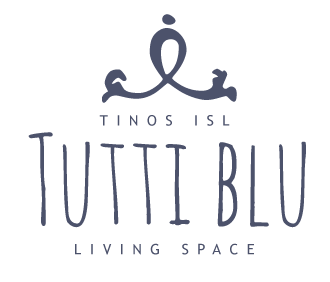About Tutti Blu Living Space
Contemporary Living Room
Each individual living space features a fully equipped kitchenette and dining room, independent bathroom and sleeping area. The amenities provided include, amongst others, constant hot water and under-floor heating for use throughout the year (state-of-art environmentally friendly technology), free wireless and cable connection to the internet, TV, as well as the provision of Greek breakfast (optional), created using local produce from the farmers of the area.
Guesthouse
The position of the house, as well as the philosophy of the island itself, encourages the travellers – visitors to engage with a series of activities that can compose an integrated experience for them. Apart from swimming in the crystal clear and fresh waters of the Aegean in nearby virgin beaches such as Santa Margarita, Lychnaftia, Livada, Pachia Ammos (15’-30’ drive) such activities may include hiking in the many preserved traditional footpaths, mountaineering, visiting the numerous picturesque small churches, the traditional vineyards and wineries, as well as participation in agricultural activities such as grape harvesting, spirit distilling and others. Finally, the excellent and pure local products and ingredients, in combination with the artistry of the Tinian cooks, have established the island as a proud gastronomic destination.
The position of the house, as well as the philosophy of the island itself, encourages the travellers – visitors to engage with a series of activities that can compose an integrated experience for them. Apart from swimming in the crystal clear and fresh waters of the Aegean in nearby virgin beaches such as Santa Margarita, Lychnaftia, Livada, Pachia Ammos (15’-30’ drive) such activities may include hiking in the many preserved traditional footpaths, mountaineering, visiting the numerous picturesque small churches, the traditional vineyards and wineries, as well as participation in agricultural activities such as grape harvesting, spirit distilling and others. Finally, the excellent and pure local products and ingredients, in combination with the artistry of the Tinian cooks, have established the island as a proud gastronomic destination.
History and Architecture
Tutti Blu Living Space is situated in the small, traditional village of Mesi, in up-country Tinos Island, within the Cyclades, Greece. Mesi (the meaning of which in Greek is “in the middle”) sits literally in the middle between two of the bigger villages of the area, namely Falatados and Steni, in the plateau under the magnificent rocky hill of Xombourgo, where the ruins of a Venetian Castle, seat of the Venetian administration on the island during the Venetian Era lie.
Architecturally, the way this house was constructed represents a typical example of Cycladic, vernacular architecture, where the building materials, house orientation and microclimate conditions of the area were used in order to provide comfortable living conditions through natural means throughout the year – fresh in the summer, yet warm in the winter.


